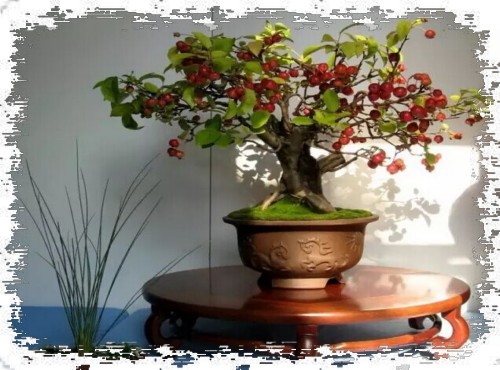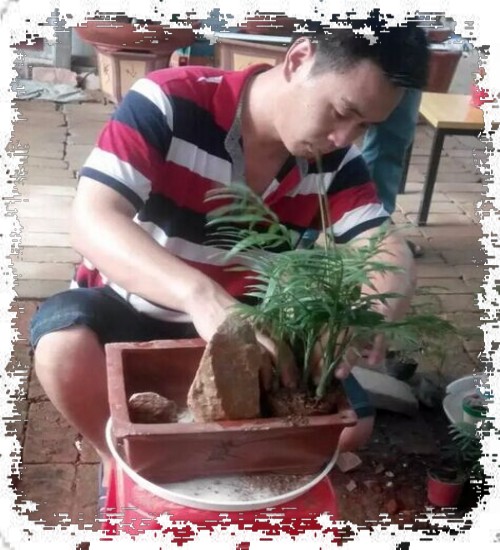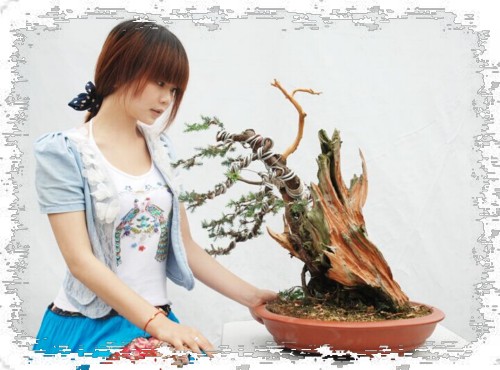Production method of Hawthorn bonsai
Hawthorn, also known as Shanlihong, Hawthorn fruit, is a deciduous shrub or small tree of Hawthorn of Rosaceae. The plant is much branched, the bark is dark brown, the branches are unarmed or less prickly, the leaves are triangular-ovate or rhombic-ovate, the leaves are dark green and glossy, and the edges are sparsely serrated. Corymbose inflorescences, drawn from branch tips or upper leaf axils, florets white, blooming from May to June. The fruit is nearly spherical or oblate, showing crimson or orange or yellow after ripening from September to October, with more light-colored spots.

Variety:
There are many varieties of Hawthorn, and its plant size, leaf shape, size and fruit size are all different. The small fruit is only 0.8 cm in diameter and the large fruit is 3 cm to 4 cm in diameter. The Hawthorn used to make bonsai should choose those varieties that are not large, but are vigorous and simple, with small leaves, easy to hang fruit, bright fruit color, and suitable for potted plants. such as "Wild Hawthorn", "North Hawthorn", "South Hawthorn", "Hubei Hawthorn", "Shandong Golden Star", "Yanguo Red", "Fuli Red" and so on.
Put on the basin:
The transplanting of Hawthorn is carried out from defoliation in autumn to sprouting in spring. Because of its few fibrous roots, it should be dipped in mud to keep fresh and moisturizing. Re-cut according to the shape of the tree before planting, cut off the main root, for the excavation time is too long, serious water loss of the stump should be soaked in clear water for a period of time to replenish water. First planted in the sand "billet", planting should be deep, do not show roots, pour water after planting, often spray water to the plant, can also be covered with plastic bags to moisturize. In the first year after the survival of the stump, in addition to the necessary pruning and traction, generally do not do too much modeling, in order to promote the formation of new roots. The following spring moved into the basin, and gradually shaped to cultivate a beautiful crown.
Trim:
Because of its developed root system and strong germination, it is necessary to pay attention to thinning the branches and leaves that are too dense at ordinary times. for the more prosperous new shoots, they can leave 4 to 6 leaves to pick the heart when they grow to about 20 cm, so as to promote the growth of short branches hanging fruit. Pruning and shaping is carried out during the dormant period, thin and weak branches, over-dense branches and overgrown branches that disturb the shape of the tree are cut off, the stout medium and short branches are retained, the overlong branches extending outward are retracted, the rear branches are made strong, and attention is paid to the retraction of the crown, cutting off the branches in the upper part of the crown, retaining the lower branches, and cultivating them into a shorter new crown.
Shape:
The shape of Hawthorn bonsai can be processed into big tree type, upright type, cliff type, water-facing type, oblique dry type and other different forms of bonsai according to the shape of tree stump and material. Because of its large leaves, the crown is mostly made into natural type, and consider the natural collocation of crown and branch, leaf and fruit, and the level between branches and branches should not be too dense, in order to show the natural landscape full of fruit branches.
The modeling method should be pruned, flat tied and pulled at the same time, in which flat binding and pulling should be carried out in the growing season, because the branches of Hawthorn are hard and brittle, the bending range should not be too large, pruning is mostly carried out in the dormant season, and the germinating power of Hawthorn is strong. Re-cutting can be carried out under the condition of keeping the tree shape graceful. In the process of modeling, the root can be raised gradually to make it hang the root and reveal its claws, so as to improve the ornamental.
Fertilization:
Hawthorn has strong habits, like sunny and warm and humid environment, slightly resistant to shade, cold, drought and barren, not strict on soil, but grows better in sandy soil with fertile, loose and good drainage and permeability. During the growing period, it was maintained in an outdoor ventilated and transparent place, and the water was watered thoroughly. From March to April before flowering, the mixed liquid fertilizer of phosphorus and nitrogen was applied once or twice, and the liquid fertilizer with high content of phosphorus and potassium was applied every 15 days.
Turn the basin:
Keep away from the wind and the sun in winter, pay attention to soil moisture and replenish water in time. Turn the pot every other year in spring or autumn to improve its fruit hanging rate.
Time: 2019-05-26 Click:
- Prev

DIY making Picture and text course of Landscape Bonsai
Nonsense aside, today let's take a look at the mountain and stone bonsai of bamboo + Luohansong, the bonsai of Luohan bamboo + copper grass, the miniature coconut + the bonsai of Luohansong, how about the mountain and stone bonsai of Luohansong? After looking at the above pictures, do you really want a basin?
- Next

Production technology of juniper bonsai
Juniper, also known as juniper, cypress, juniper, is an evergreen tree of the genus Sabina of the family Cypress, with brown bark, longitudinal grooves and strip peeling off. Branches spread upward, branchlets drooping, trigonous, green at first, then reddish brown. Trefoil verticillate, needle-shaped, apex sharp, surface slightly concave, midrib slightly raised
Related
- Fuxing push coffee new agricultural production and marketing class: lack of small-scale processing plants
- Jujube rice field leisure farm deep ploughing Yilan for five years to create a space for organic food and play
- Nongyu Farm-A trial of organic papaya for brave women with advanced technology
- Four points for attention in the prevention and control of diseases and insect pests of edible fungi
- How to add nutrient solution to Edible Fungi
- Is there any good way to control edible fungus mites?
- Open Inoculation Technology of Edible Fungi
- Is there any clever way to use fertilizer for edible fungus in winter?
- What agents are used to kill the pathogens of edible fungi in the mushroom shed?
- Rapid drying of Edible Fungi

